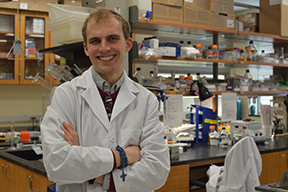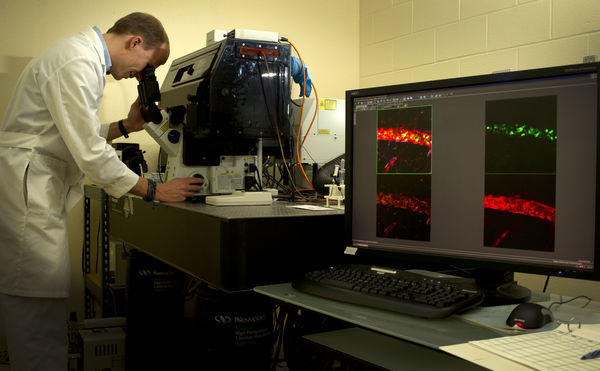
As a WFIRM biomedical engineering intern under the guidance of Dr. Frank C. Marini, Cowdrick worked as a team leader developing advanced multiphoton microscopy and image processing methodologies to be used for evaluating the regeneration of normal and tissue-engineered organs. His team imaged organs on the cellular level, using biological fluorescence microscopy, to gain new insights into the mechanisms governing how stem cells reconstruct human tissue. Their work will help provide fundamental knowledge to accelerate stem cell therapies from the bench to the bedside.
He has also been working with Dr. Siyuan Zhang, the Nancy Dee Professor of Cancer Research at the Harper Cancer Research Institute (HCRI) at Notre Dame. In fact, he is in his third year as an HCRI team member, where he has been focusing on exploring the impact that the tumor microenvironment has on early-stage metastatic breast cancer evolution in the brain. Often, by the time a primary tumor has been detected, cancerous cells have already disseminated from the primary site throughout the body.

When a cancer stem cell migrates from primary tissue and integrates itself inside distant organs such as the brain, there is generally a period of
dormancy spanning anywhere from one to ten years before an overt metastasis is detected. This is long after initial treatment should occur. The
goal of his work at HCRI is to understand the mechanisms governing early metastatic movement and identify potential therapeutic targets in order to exploit this window of dormancy, ultimately preventing the development of the cancer.
As excited as he is about the research, and living his dream, Cowdrick emphasizes that his journey has not been a solitary one. “I would not have been able to take advantage of these opportunities without the support from my faculty mentor or the other tools here at Notre Dame. Research is about
learning, constantly learning. Coursework is part of that, but so are library resources, the Center for Undergraduate Scholarly Engagement, and funded research opportunities,” he says. Cowdrick also stresses that, as with many research avenues today, an interdisciplinary team of scientists, engineers, and physicians will be needed to ultimately design a clinically translatable solution that meets the complex physiological needs of today’s breast cancer patients in a real and life-changing way. To that end, when he graduates
from Notre Dame, he will be pursuing a doctorate in biomedical engineering, blending his foundation in chemical engineering principles with cutting-edge medical research and a passion to serve the common good. “It is,” according to Cowdrick, “a dream worth fighting for.”